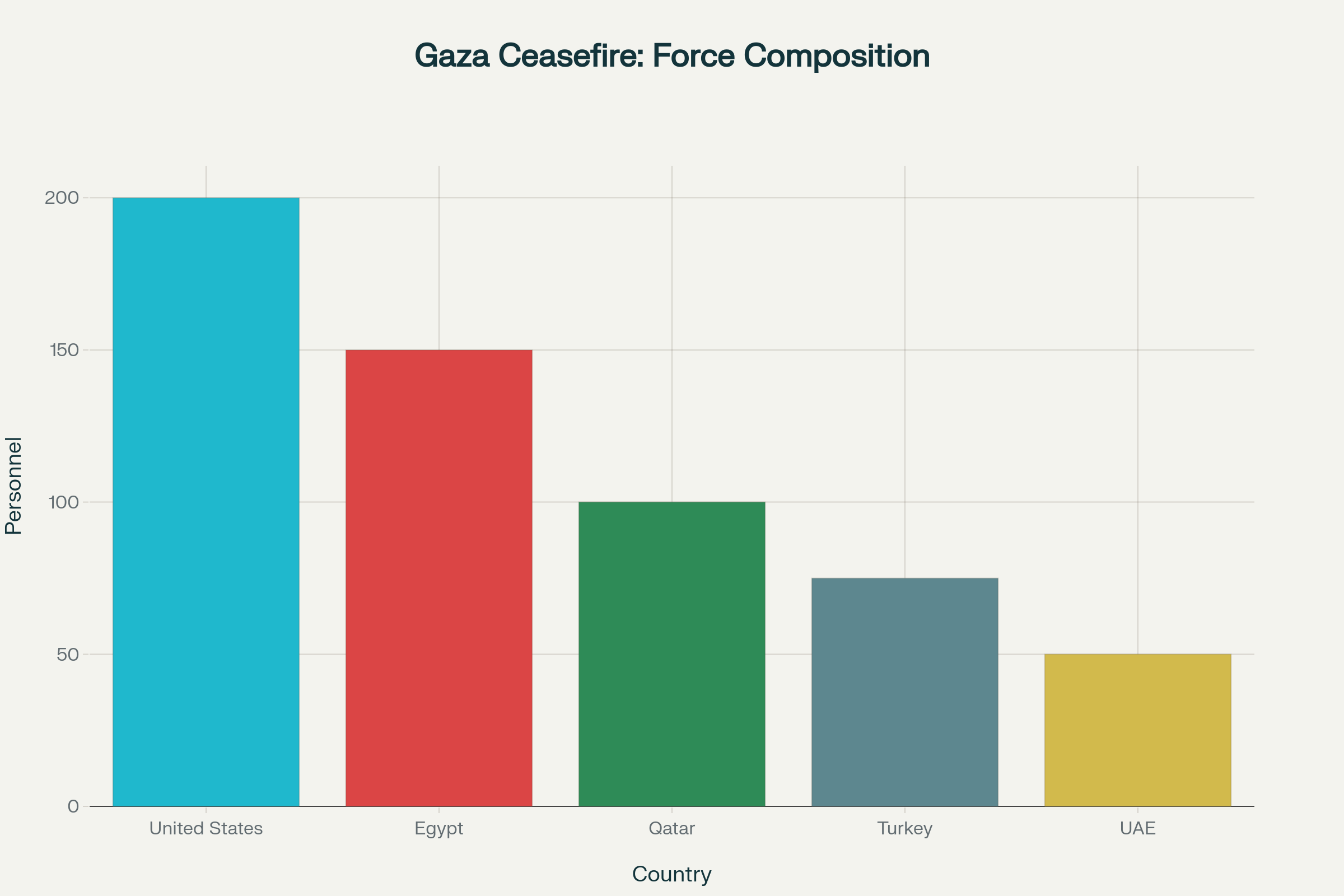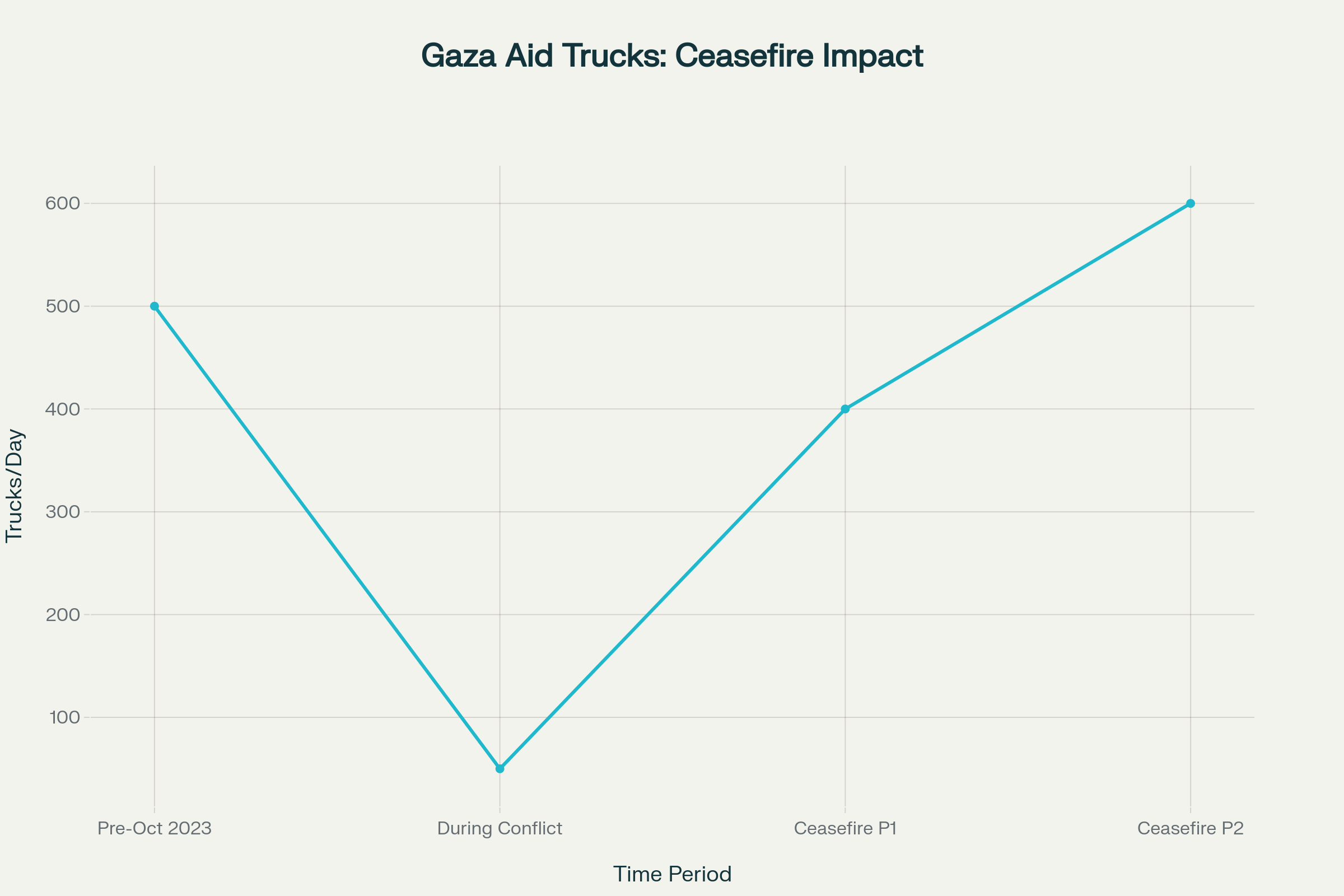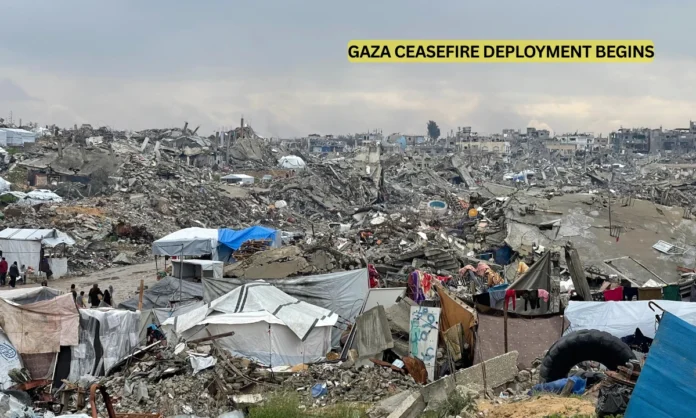Key Highlights
- Gaza ceasefire deployment establishes first American-led multinational peacekeeping task force with 575 total personnel
- Coordination center facilitates 600 daily aid trucks entering Gaza, tripling humanitarian supply capacity
- Multi-phase Gaza ceasefire deployment timeline extends through 2026 with expanding international cooperation
The United States has initiated a comprehensive Gaza ceasefire deployment involving 200 specialized military personnel to oversee the implementation of a historic peace agreement between Israel and Hamas. The Gaza ceasefire deployment represents the most significant American military commitment to Middle East peacekeeping operations since the Abraham Accords, establishing a multinational coordination framework designed to ensure compliance and facilitate humanitarian assistance.
President Donald Trump’s administration confirmed that the Gaza ceasefire deployment personnel are drawn from US Central Command positions across the region, with Admiral Brad Cooper serving as operational commander of the joint task force. The deployment commenced October 10, 2025, as part of Trump’s comprehensive 20-point peace initiative, which secured approval from both Israeli leadership and Hamas through extensive mediation by Egypt, Qatar, and Turkey.
Senior Pentagon officials emphasized that the Gaza ceasefire deployment maintains strict operational boundaries, with no American forces entering Gaza territory itself. The mission focuses on establishing a Civil-Military Coordination Center that monitors compliance, coordinates humanitarian aid distribution, and maintains communication channels between all parties to prevent ceasefire violations.
The Gaza ceasefire deployment operates alongside international partners contributing an estimated 375 additional personnel, creating a total multinational force of approximately 575 monitoring specialists. Military representatives from Egypt, Qatar, Turkey, and the United Arab Emirates form the core coalition supporting American leadership of the coordination center.

Multinational force composition for Gaza ceasefire deployment monitoring operations
Strategic Command Structure and International Framework
The Gaza ceasefire deployment functions under direct oversight of US Central Command, with Admiral Brad Cooper leveraging his participation in diplomatic negotiations that produced the ceasefire agreement. Cooper’s leadership demonstrates Washington’s strategic commitment to ensuring successful implementation of the peace initiative through coordinated international cooperation.
- Joint Control Center integrates multinational forces to prevent conflicts between Israeli Defense Forces and participating nations
- Real-time communication systems relay ground conditions and potential violations to diplomatic channels
The Civil-Military Coordination Center established through the Gaza ceasefire deployment serves dual functions as both monitoring station and humanitarian coordination hub. Officials indicate that the center facilitates humanitarian aid flow, logistical support, and security assistance while maintaining continuous communication with Israeli forces, Hamas representatives through Egypt and Qatar, and international partners.
Military planners designed the Gaza ceasefire deployment to integrate seamlessly with existing regional security frameworks while avoiding direct confrontation or territorial occupation. The coordination mechanism operates through established diplomatic channels, ensuring that information about ground conditions and potential ceasefire violations reaches all parties through appropriate intermediaries.
The Gaza ceasefire deployment timeline indicates full operational capability by October 13, 2025, with personnel arriving from various CENTCOM locations and global positions. Military specialists bring expertise in transportation, logistics, planning, security, and engineering to support the complex coordination requirements of the multinational mission.
Humanitarian Aid Coordination and Infrastructure Development
The Gaza ceasefire deployment coincides with the largest humanitarian relief operation in Gaza’s recent history, designed to address critical needs of the territory’s 2.1 million residents. Israeli security officials confirmed that the coordination framework enables 600 aid trucks daily to enter Gaza, representing a twelve-fold increase from conflict-period deliveries averaging 50 trucks per day.
| Ceasefire Phase | Daily Truck Limit | Duration | Total Weekly Capacity |
|---|---|---|---|
| Pre-Conflict (2023) | 500 trucks | Ongoing | 3,500 trucks |
| During Conflict | 50 trucks | 24 months | 350 trucks |
| Phase 1 (Days 1-5) | 400 trucks | 5 days | 2,000 trucks |
| Phase 2 (Ongoing) | 600 trucks | 40+ days | 4,200 trucks |
The Gaza ceasefire deployment coordination mechanism oversees distribution of essential supplies from UN organizations, private sector partners, and participating nations. Aid packages encompass cooking gas, food supplies, medical equipment, shelter provisions, and specialized equipment for repairing critical infrastructure including water systems, sewage networks, and essential services.
UN Relief Chief outlined a comprehensive 60-day plan to deliver vital aid through the Gaza ceasefire deployment framework, targeting 2.1 million people requiring food assistance and approximately 500,000 people needing specialized nutritional support. UNICEF positioned more than 1,300 trucks around Gaza containing tents, nutrition supplies, medical equipment, and emergency provisions.

Daily humanitarian aid truck deliveries to Gaza showing improvement after ceasefire deployment
Infrastructure restoration represents a critical component of the Gaza ceasefire deployment mission, with coordination center managing complex logistics of rebuilding damaged infrastructure while maintaining security protocols. The deployment facilitates entry of heavy equipment for debris removal and essential services restoration, preventing military equipment infiltration through comprehensive screening procedures.
Regional Security Implications and Diplomatic Expansion
The Gaza ceasefire deployment extends beyond monitoring functions, serving as a foundation for broader regional diplomatic initiatives and potential expansion of the Abraham Accords normalization framework. Senior US officials identified successful implementation as creating conditions for additional normalization agreements between Israel and Arab nations including Saudi Arabia, Indonesia, Mauritania, Algeria, Syria, and Lebanon.
- Abraham Accords precedent demonstrates potential for expanded diplomatic cooperation through successful peacekeeping
- Regional stability improvements facilitate economic partnerships and security cooperation arrangements
President Trump’s previous Abraham Accords success, establishing normalization between Israel and Bahrain, UAE, Morocco, and Sudan, provides a diplomatic template for leveraging Gaza ceasefire deployment achievements into broader regional peace initiatives. The multinational task force composition demonstrates existing cooperation foundations supporting expanded diplomatic arrangements.
The Gaza ceasefire deployment emphasizes international cooperation and shared responsibility, reflecting strategic approaches to regional security that reduce direct American military involvement while maintaining influence through coalition leadership. This model could serve as a prototype for future Middle East peacekeeping operations and conflict resolution mechanisms.
Regional security experts note that successful Gaza ceasefire deployment implementation in preventing violations and facilitating humanitarian aid could demonstrate effectiveness of multinational approaches to complex conflicts. The mission’s coordination emphasis rather than occupation aligns with strategic trends toward burden-sharing among allied nations.
Operational Timeline and Long-term Strategic Objectives
The Gaza ceasefire deployment operates under flexible timeline parameters, with officials acknowledging significant variables regarding mission duration and evolving requirements. The initial phase focuses on establishing operational capabilities and demonstrating effectiveness of the multinational coordination model through measurable compliance metrics.
- Site survey teams completed preliminary assessments enabling rapid deployment initialization
- Scalable operations adapt to changing conditions based on compliance levels and humanitarian needs
Military planners structured the Gaza ceasefire deployment to accommodate changing conditions and evolving mission requirements as the peace agreement progresses through planned phases. The adaptive approach allows scaling operations based on compliance levels, humanitarian demands, and regional stability conditions, ensuring sustainable long-term effectiveness.
The coordination center established through the Gaza ceasefire deployment serves as a model for potential future peacekeeping operations in regional conflicts. Military officials emphasized that mission success could influence American approaches to similar international interventions and coalition-building efforts throughout the Middle East and beyond.
Phase-specific objectives of the Gaza ceasefire deployment include hostage release coordination during the initial 72-hour window, followed by prisoner exchange facilitation and infrastructure reconstruction oversight. The mission timeline extends through multiple phases, with each stage building upon previous achievements to establish sustainable peace mechanisms.
Final Assessment
The Gaza ceasefire deployment of 200 American military personnel leading a 575-person multinational task force represents a carefully calibrated response to one of the Middle East’s most persistent conflicts. The mission’s emphasis on coordination rather than occupation, combined with its multinational structure and comprehensive humanitarian focus, reflects evolved approaches to regional peacekeeping that prioritize sustainable solutions over military dominance.
Success of this Gaza ceasefire deployment could establish new precedents for American involvement in Middle East conflicts while demonstrating effectiveness of coalition-based approaches to complex regional challenges. As the coordination center facilitates unprecedented humanitarian aid flows and maintains ceasefire compliance, the deployment’s performance will likely influence future diplomatic initiatives and regional security arrangements throughout the broader Middle East region.


